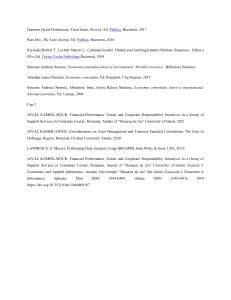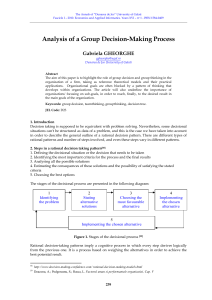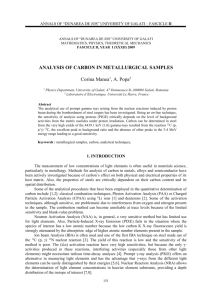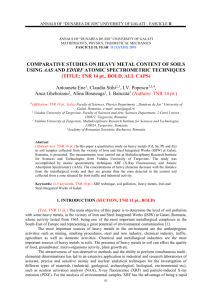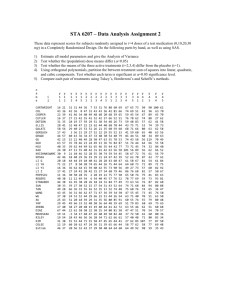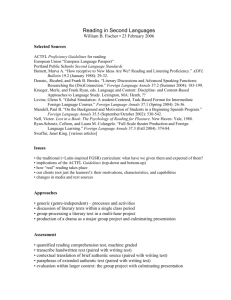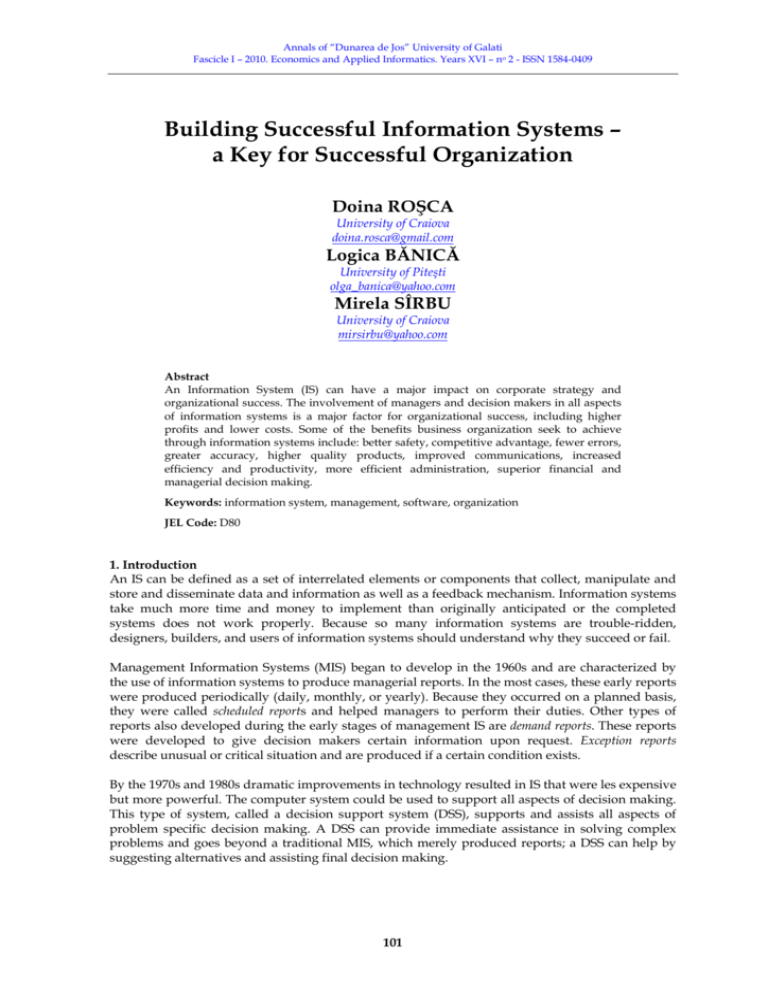
Annals of “Dunarea de Jos” University of Galati
Fascicle I – 2010. Economics and Applied Informatics. Years XVI – no 2 - ISSN 1584-0409
Building Successful Information Systems –
a Key for Successful Organization
Doina ROŞCA
University of Craiova
doina.rosca@gmail.com
Logica BĂNICĂ
University of Piteşti
olga_banica@yahoo.com
Mirela SÎRBU
University of Craiova
mirsirbu@yahoo.com
Abstract
An Information System (IS) can have a major impact on corporate strategy and
organizational success. The involvement of managers and decision makers in all aspects
of information systems is a major factor for organizational success, including higher
profits and lower costs. Some of the benefits business organization seek to achieve
through information systems include: better safety, competitive advantage, fewer errors,
greater accuracy, higher quality products, improved communications, increased
efficiency and productivity, more efficient administration, superior financial and
managerial decision making.
Keywords: information system, management, software, organization
JEL Code: D80
1. Introduction
An IS can be defined as a set of interrelated elements or components that collect, manipulate and
store and disseminate data and information as well as a feedback mechanism. Information systems
take much more time and money to implement than originally anticipated or the completed
systems does not work properly. Because so many information systems are trouble-ridden,
designers, builders, and users of information systems should understand why they succeed or fail.
Management Information Systems (MIS) began to develop in the 1960s and are characterized by
the use of information systems to produce managerial reports. In the most cases, these early reports
were produced periodically (daily, monthly, or yearly). Because they occurred on a planned basis,
they were called scheduled reports and helped managers to perform their duties. Other types of
reports also developed during the early stages of management IS are demand reports. These reports
were developed to give decision makers certain information upon request. Exception reports
describe unusual or critical situation and are produced if a certain condition exists.
By the 1970s and 1980s dramatic improvements in technology resulted in IS that were les expensive
but more powerful. The computer system could be used to support all aspects of decision making.
This type of system, called a decision support system (DSS), supports and assists all aspects of
problem specific decision making. A DSS can provide immediate assistance in solving complex
problems and goes beyond a traditional MIS, which merely produced reports; a DSS can help by
suggesting alternatives and assisting final decision making.
101
Annals of “Dunarea de Jos” University of Galati
Fascicle I – 2010. Economics and Applied Informatics. Years XVI – no 2 - ISSN 1584-0409
Information systems literacy goes beyond a knowledge of the fundamentals of computer systems
and equipment. Most important it encompasses how and why this technology is applied in
business; a knowledge of organizations are all important parts of IS literacy. [5]
2. The contribution of information systems to the total quality management
Is difficult to say what make a successful information system. But if we had to generalize, a
successful system will be accurate, reliable, will work as intended, and will be widely used. If IS
are high quality it will help to promote overall quality throughout the organization.
A quality system will do the following:
achieve the business goals articulated by the user department;
operate at an acceptable cost, commensurate with the value produced for the firm;
meet carefully defined performance standards (such as response time and system availability);
produce accurate, reliable output;
be easy to learn and use;
be flexible.
Information systems are used in all functional areas (operating divisions) of business:
in finance and accounting, IS are used to forecast business activity, determine the best sources
and uses of founds, manage cash and other financial resources, analyze investments and
perform audits, ensure that all financial reports and documents are accurate;
in marketing, IS are used to develop new goods and services (product analysis), determine the
best location for production and distribution facilities, determine the best advertising and sales
approaches (promotion analysis) and make price analysis;
in manufacturing, IS are used to process customer orders, develop production schedules,
control inventory levels and monitor product quality;
in addition, IS are used to design products (CAD - computer assisted design) and manufacture
items (CAM - computer assisted manufacturing).
Information systems are also used in almost every industry or field:
airline industry uses IS to make seat reservation, to determine the best schedules, to determine
which type of plane should fly which particular route;
investments firms use IS to analyze stocks, options, the future market and other financial
instruments;
banks use IS to make good investments;
transportation industry uses IS to schedule trucks and trains to deliver goods and services at the
least cost;
health care organizations use IS to diagnose illnesses, plan medical treatment and bill patients.
There was identified five types [1] of IS: transaction processing systems (TPS), management information
systems (MIS), office-automation systems (OAS), executive support systems (ESS) and decision-support
system (DSS). There are a strong relationship of these types of systems and the business activities.
Considering the use of information systems inside the organization, a number of researchers have
identified three levels or types of activity that can benefit.
These three levels were defined [1] as:
operational control - the process of assuring that specific tasks are carried out;
management control - the process by which managers assure that resources are obtained and
used effectively;
strategic planning - the process of deciding on objectives of organization, on changes in these
objectives, on the resources used in attainting these objectives.
Also, were identified three degree of structure involved in the process. By degree of structure is
meant the amount of human judgment and evaluation required in the activity. Structured activity
requires little judgment, evaluation, or insight; in structured activities, much of the decision
102
Annals of “Dunarea de Jos” University of Galati
Fascicle I – 2010. Economics and Applied Informatics. Years XVI – no 2 - ISSN 1584-0409
making can be automated. Unstructured activity requires considerable judgment, evaluation, and
human creativity, and is very difficult to automate.
TPS are used primarily for structured operations and, to a lesser degree, management control
applications. MIS are used primarily for semistructured management control applications,
although it overlap into the operational and strategic planning as well. DSS are used primarily for
unstructured decision making, whether that occurs at the operational, management or planning
levels. ESS are used primarily for structured management and strategic planning. applications.
OAS are used for office correspondence and communication and are used in all the domain (Fig.
1.).
Operational
Control
Management
Control
TPS
Structured
Strategic
Planning
ESS
Semistructured
MIS
Unstructured
DSS
OAS
Figure 1. Relationship of system types and business activities
Increasingly, information systems are bringing about changes in business goals, relationships with
customers and suppliers, and internal operations. Today, this process typically places thousands of
terminals or microcomputers on the desks of employees who have little experience with them,
connecting the devices to powerful communications networks, rearranging social relations in the
office and work locations, changing reporting patterns and asking employees to achieve higher
levels of productivity. The rapid growth in international trade and the emergence of a global
economy call for information systems that can support both producing and selling goods in many
different countries.
Information systems and organizations have a mutual influence on each other. Information
systems must be aligned with the organization to provide information needed by important groups
within the organization. At the same time, the organization must be aware of and open itself to the
influences of IS to benefit from new technologies. This complex two-way relationship [3] is
mediated by many factors (Fig. 2.).
An organization is a stable formal social structure that takes resources from the environment and
processes them to produce outputs. The primary production factors provided by the environment capital and labor - are transformed by the firm through the production process into products and
services - outputs to the environment. The products and services are consumed by the
environment which supplies additional capital and labor as inputs in the feedback loop.
Organizational culture is a set of fundamental assumptions about what products the organization
should produce, how and where it should produce them, and for whom they should be produced.
Standard operating procedures are a precise, defined rules for accomplishing tasks that have been
developed to cope with expected situations. People in organizations occupy different positions
with different specialties, concerns, and perspectives. As a result, they naturally have divergent
viewpoint about resources, rewards, and punishments should be distributed. These differences
103
Annals of “Dunarea de Jos” University of Galati
Fascicle I – 2010. Economics and Applied Informatics. Years XVI – no 2 - ISSN 1584-0409
matter to members of organizations, both managers and employees, and they result in political
struggle, competition within every organization.
Mediating factors:
▪ environment
▪ culture
▪ structure
▪ standard procedures
▪ politics
▪ management decisions
▪ chance
Organizations
Information
Technology
Figure 2. The two-way relationship between organizations and information technology
3. Identify successful information systems versus problem areas
The traditional answer to the question "Why do organizations adopt information systems?" was "To
become more efficient, to save money, and to reduce the work force". Although this response may
have been generally true in the past, now it is not the primary reason for adopting systems. IS have
become vitally important simply to stay in business. Improvements in decision making (speed,
accuracy, comprehensiveness), server ever higher customer and client expectations, coordinating
dispersed groups in an organization have become important reasons for building systems.
External environmental factors and internal institutional factors influence the types of information
systems the organizations select, develop, and use. Some external environmental factors are rising
costs of labor or other resources, the competitive actions of other organizations, and changes in
government regulations. These can be thought of as environmental constraints. At the same time, the
environment also provides organizations with opportunities: new technologies, new sources of
capital, the development of new production processes, or a new government program that
increases the demand for certain products. Institutional factors influence the adoption and design
of IS. They include values, norms, and vital interests that govern matters of strategic importance to
the organization.
System development
▪ adoption
▪ utilization
▪ management
Environmental factors
▪ constraints
▪ opportunities
Institutional factors
▪ values
▪ norms
▪ interests
Figure 3. The system development process
In according with many developers projects it was identified numerous factors that contribute to
good systems development. These factors include:
support of top-level managers;
104
Annals of “Dunarea de Jos” University of Galati
Fascicle I – 2010. Economics and Applied Informatics. Years XVI – no 2 - ISSN 1584-0409
involvement of users at all stages;
use of a proven systems development methodology;
clearly defined system goals and objectives;
a focus on the most important problems and opportunities;
good training programs for all involved;
a well-defined and organized maintenance program.
Information systems quality can be minimized by using traditional and new systems development
methodologies, software metrics, quality tools, through testing procedures, and by reallocating
resources to put more emphasis on the early stages of systems development cycle. Structured
analysis highlights the flow of data and the processes through which data are transformed. Its
principal tool is the data flow diagram. Structured design and programming are software
disciplines that produce reliable, well-documented software with a simple, clear structure that is
easy for other to understand and maintain. System flowcharts are useful for documenting the
physical aspects of system design.
Computer-aided software engineering (CASE) automates methodologies for systems development.
It promotes standards and improves coordination and consistency during systems development.
CASE tools help system builders build a better model of system and facilitate revision of design
specifications to correct errors. Object-oriented software development is expected to reduce the
time and cost of writing software and of making maintenance changes because it models a system
as a series of reusable objects that combines both data and procedures. Software re-engineering
helps system builders reconfigure aging software to conform to structured design principles,
making it easier to maintain.
Communication problems between end users and designers are a major reason why user
requirements are not properly incorporated into information systems and why users are driven out
of the implementation process. Users and information system specialists tend to have different
backgrounds, interests, and priorities, and often pursue different goals. This is referred to as the
user-designer communications gap. Information system specialists, for example, often have a
highly technical or machine orientation to problem solving. They look for elegant and sophisticated
technical solutions in which hardware and software efficiency is optimized at the expense of easy
of use or organizational effectiveness. Users, on the other hand, prefer systems that are oriented to
solving business problems or facilitating organizational tasks. Often the orientation of booth
groups are so at odds that they appear to speak in different tongues.
Systems differ dramatically in their size, scope, level of complexity, and organizational and
technical components. The larger the project - as indicated by the money spent, the size of the
implementation staff, the time allocated to implementation, and the number of organizational units
affected - the greater the risk. Projects that are more highly structured run a much lower risk than
those whose requirements are relatively undefined, fluid, and constantly changing; when
requirements are clear and straightforward, outputs and processes can be easily defined. Users in
highly structured projects tend to know exactly what they want and what the system should do.
The conflicts and uncertainties inherit in any implementation effort will be magnified when an
implementation project is poorly managed and organized. Training to ensure that the end users are
comfortable with the new system and fully understand its potential uses is often sacrificed, in part
because the budget is strained toward the end of a project.
A systems development project without proper management will most likely suffer vast cost
overruns, major time slippages, and technical performances that fall significantly below the
estimated level.
Many information systems failures are not necessarily falling apart, but thy clearly are either not
used in the way that they are intended, or they are not used at all. Users have to develop parallel
105
Annals of “Dunarea de Jos” University of Galati
Fascicle I – 2010. Economics and Applied Informatics. Years XVI – no 2 - ISSN 1584-0409
manual procedures to make these systems work properly. These failures can be traced to four basic
information system problems: design, data, cost, and operations.
SI problems
DESIGN
- the system fails to capture essential business requirements
- information may not be provided by system quickly enough or in a usable
format
- some systems go unused because they were designed with a poor user
interface
DATA
- the data in the system have a high level of inaccuracy, or incompleteness
- the data may not be broken out properly for business purposes
COST
- some systems cost so much to implement or operate that they cannot be
justified by the demonstrated business value of the information they provide
OPERATIONS
- information is not provided in a timely and efficient manner because the
computer operations that handle information processing may be break down
- these problems can be caused by technical, managerial, and organizational
factors
Figure 4. Problems of Information Systems
4. Controlling Information Systems
Before computer automation, data about individuals or organizations were maintained and
secured as paper records dispersed in separate business or organizational units. Information
systems concentrate data in computer files that can potentially be accessed more easily by large
numbers of people and by groups outside the organization. Consequently, automated data are
more susceptible to destruction, fraud, error, and misuse. When computers systems fail to run or
work as required, firms that depend heavily on computers experience a serious loss of business
function.
Security refers to the policies, procedures, and technical measures used to prevent unauthorized
access to alteration, theft, and physical damage to record systems. Security can be promoted with
an array of techniques and tools to safeguard computer hardware, software, communications
networks, and data.
Computers can also serve as instruments of error, severely disrupting or destroying an
organization's recordkeeping and operations. Errors in automated systems can occur at many
points in the processing cycle: through data entry, program error, computer operations, and
hardware. Fig. 5 illustrates all of the points in a typical processing cycle where errors can occur.
106
Annals of “Dunarea de Jos” University of Galati
Fascicle I – 2010. Economics and Applied Informatics. Years XVI – no 2 - ISSN 1584-0409
Data preparation
Transmission
Conversion
Form completion
Online data entry
Keypunching
Optical scanning
Other input
Validation
Processing/File maintenance
Output
Transmission
Distribution
Figure 5. Points in the processing cycle where errors can occur
To minimize errors, special policies and procedures - named controls - must be incorporated into
design and implementation of information systems. There are two main categories of control:
general controls - control the design, security, and use of computer programs and the security of
data files in general throughout the organization; they include physical hardware controls,
system software controls, data files security controls, computer operations controls, controls
over the system implementation process, administrative disciplines;
application controls - specific controls unique to each computerized application, such as payroll,
accounts receivable, and order processing; they focus on the completeness and accuracy of
input, updating and maintenance, and the validity of the information in system.
To determine what controls are required, designers and users of systems must identify all of the
control points and control weaknesses and perform risk assessment. They must also perform a
cost/benefit analysis of controls and design controls that effectively safeguard systems without
making them unusable.
Implementation controls audit the system development process at various points to ensure that it
is properly controlled and managed. The system development audit should look for the presence
of formal review points at various stages of development that enable users and management to
approve or disapprove the implementation.
107
Annals of “Dunarea de Jos” University of Galati
Fascicle I – 2010. Economics and Applied Informatics. Years XVI – no 2 - ISSN 1584-0409
The system development audit should also examine the level of user involvement at each stage of
implementation and check for the use of a formal cost/benefit methodology in establishing system
feasibility. Without a good documentation that shows how a system operates from both a technical
and a user standpoint, an IS nay be difficult to operate, maintain, or use.
5. Conclusion
We have tried to explore various facets of successful information system throughout this text. We
identified some problem areas and causes of information system failure. The sources of system
success or failure are both technical and organizational. Both traditional and new methodologies
should be used for promoting software quality. The success of organizational change can be
determinated by how well information systems specialists, and users, and decision makers deal
with key issues at various stages during implementation. Information system design and entire
implementation process should be managed as planned organizational change. Sociotechnical
design emphasizes the participation of the individuals most affected by a new system and aims for
an optimal blend of social and technical solutions.
References
1. David M. Kroenke, Kathleen A. Dolan - "Business Computer Systems - An introduction", Mc Graw-Hill, USA,
1990
2. Ralph M. Stair - "Principles of Information Systems - A managerial Approach", South-Western Publishing
Company, Boston, USA, 1992
3. Kenneth C. Laudon, Jane P. Laudon - "Essentials of Management Information Systems: Organization and
Technology", Prentice-Hall International, UK, 1995
4. Jeffrey A. Hoffer, Joey F. George, Joseph S. Valacich - "Modern Systems Analysis and Design", Pearson Prentice
Hall, 2008
5. Mazilescu V., 2009 - A Real Time Control System based on a Fuzzy Compiled Knowledge Base, Proceedings of The 13th
WSEAS International Conference on COMPUTERS, CSCC Multiconference, Rodos Island, Greece, July 23-25, 2009,
Conference track: Artificial Intelligence. Computational Intelligence, p. 459-464, ID: 620-473, ISBN 978-960-474-099-4,
ISSN 1790-5109
108

